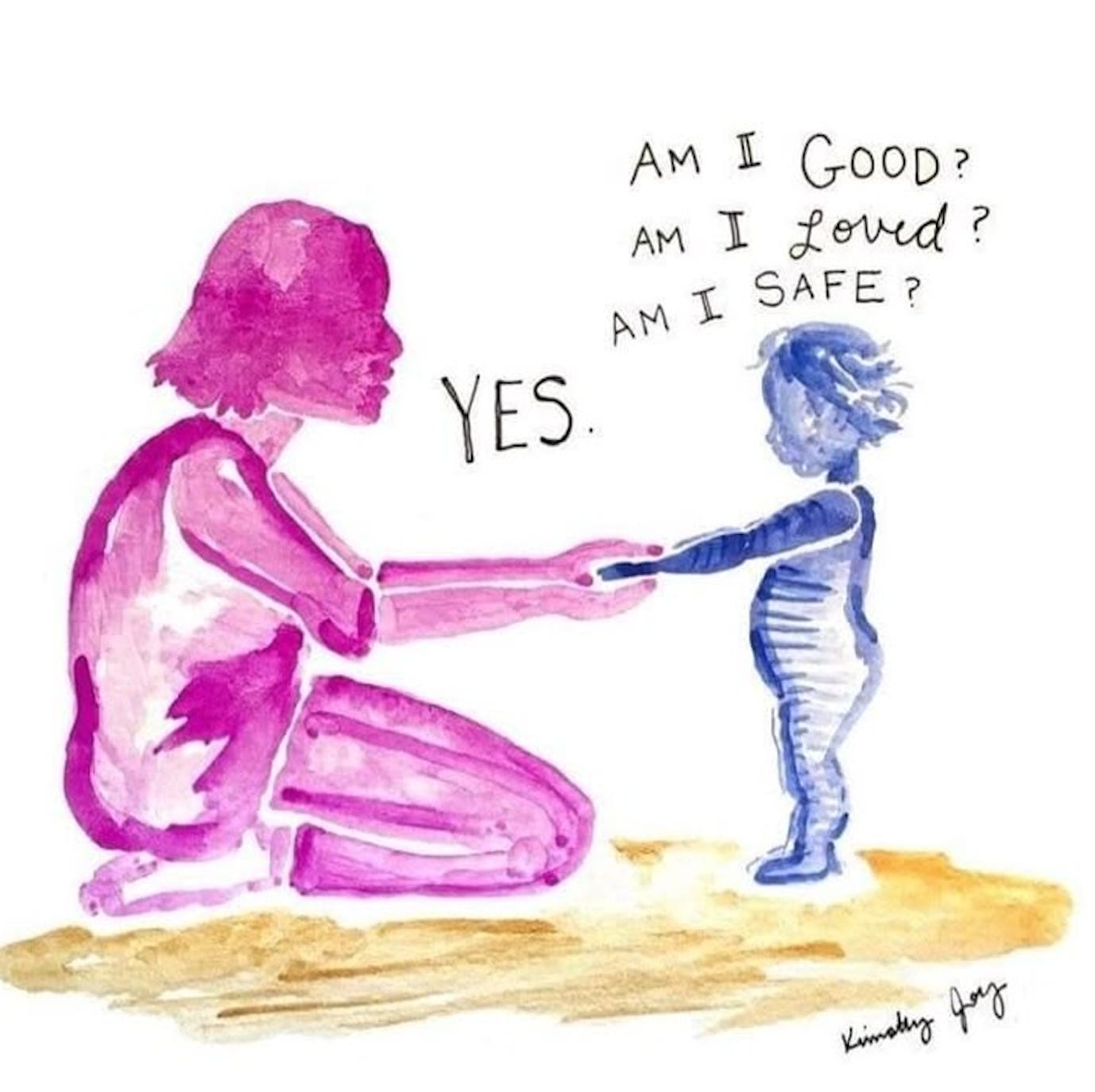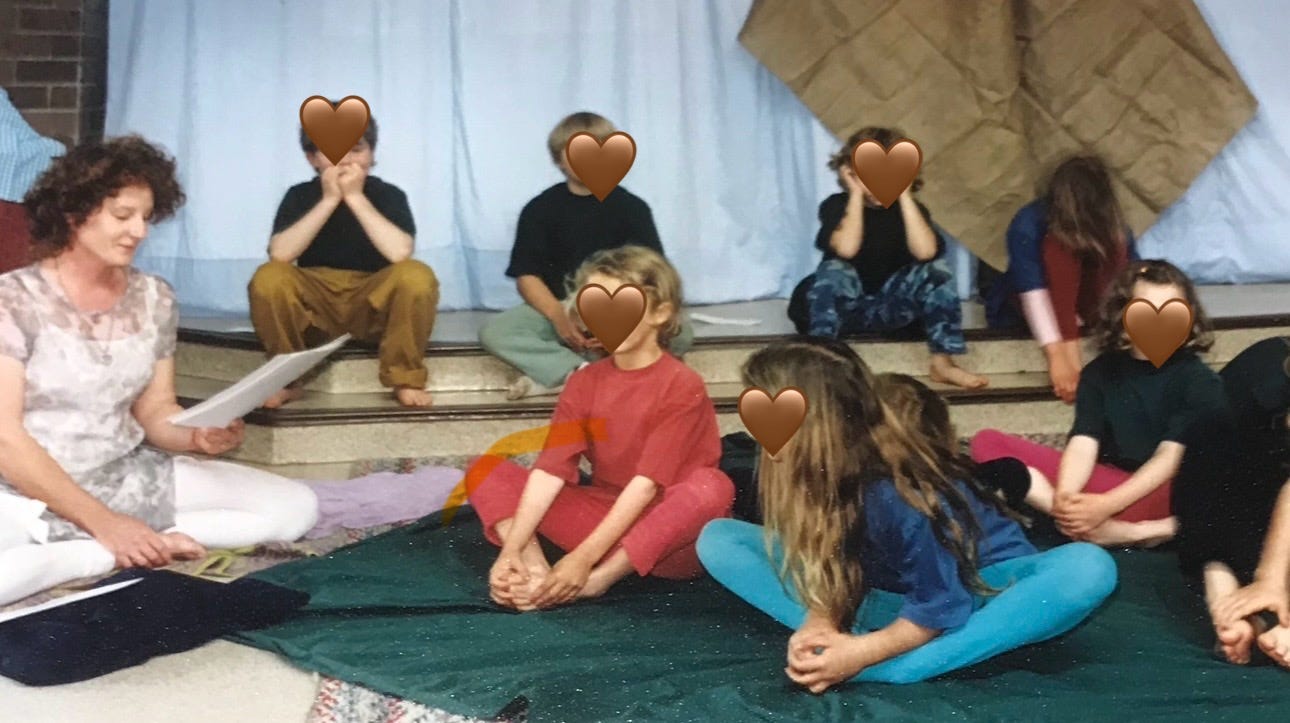Changing the World... start somewhere!
Tending the Roots Early: Nervous System Practices for the Young
Imagine a world where children are taught from the start that emotions are not disruptions, but sacred messages and messengers.
image from Pinterest
A few decades ago, when I was a Yoga Teacher in Australia, one of my greatest joys was guiding preschoolers and school-aged children—my own little ones included—through playful, soulful movement. We gathered both in classrooms and in the cozy sanctuary of my home studio. Children, in their natural brilliance, carry an innate rhythm—wild and wise. They breathe with the trees, stretch like the sun, and move with the gentle sway of the breeze. It was never about “teaching” them, really—it was about remembering alongside them. Their bodies spoke in instinct and song, and I simply followed the melody.
We have a responsibility to our children to teach them from the start that emotions are not disruptions but sacred body wisdom and messages, that a fluttering heart is not to be feared but listened to. Nervous system practices—like deep belly breathing, naming feelings, and grounding through the senses—can be introduced as early as preschool, not as a correction to dysregulation but as a celebration of being fully alive. These aren’t just tools; they are invitations for our little ones to feel safe in their own skin, to witness their own inner world with tenderness rather than judgment. I personally have had to learn or relearn some of these helpful practices as an adult, myself.
What if we taught our children that a racing pulse or a trembling lip doesn’t mean something is wrong with them, but rather, something important is happening within them? Just as they learn to tie their shoes, they can learn to soothe their bodies, to pause, to place a hand on their heart and whisper, I’m here. These practices don’t just shape calm children—they cultivate emotionally literate adults, ones who can meet life’s waves without drowning in them.
When we honour the nervous system as a garden to be tended rather than a problem to be fixed, we change the story. We raise a generation fluent in their own biology, empowered by their breath, and anchored by inner wisdom. These small sacred teachings ripple outward. The grounding stones they learn to carry in childhood become stepping stones of resilience and self-love in adulthood. Let us begin where the roots are the softest and the heart the widest open. Let us teach our children the language of presence, body awareness, and emotional intelligence.
I remember one yoga class in particular where we joyously played with the chant Om, exploring the vocal sound like a sacred toy. As you can imagine, the children embraced it with full-hearted enthusiasm. Some Oms were bold and booming, like echoes in a canyon. Others were soft and slow, flowing sweetly like a stream of golden honey. The children giggled, wriggled, and then dropped into a surprising stillness, as if they instinctively knew they were tuning into something ancient and true.
Personal yoga class photo
After we finished, little four-and-a-half-year-old Liam came up to me, eyes wide, and said, “I hear that sound all the time, everywhere.” He completed his sentence by emphasizing, “I like it. " His head nodded while he grinned.
His words moved something deep in me—a quiet, heart-expanding recognition. I held that moment like a precious jewel and later shared it with his mother, knowing she, too, would feel the sweetness.
Here are a few ideas to get you started with your children or grandchildren. Planting some treasure in their nervous systems.
Let’s Name the Feeling: The Inner Weather Report
Invite them to close their eyes and check in like they’re forecasting the weather inside.
“Is it stormy in your chest? Or sunny behind your eyes? Maybe a cloudy kind of tired in your belly?”
Let them choose their own words, encouraging poetic, descriptive language. Feelings might be:
Hot like a volcano,
Crackly like dry leaves rubbing together,
Small and hidden like a mouse in a teacup,
Big and bold like a roaring lion.
This helps normalize the emotional landscape—nothing is “too much,” it’s just weather, and all weather passes and changes.
Use the Magic of “I” Statements: Claiming Feelings Without Blame
This is where empowerment begins. Invite them to use phrases like:
I feel sad like a grey puddle today.
I feel excited—like my toes are full of jumping jellybeans!
I feel mad—it’s like there’s a dragon stomping in my tummy.
Let “I feel…” become their anchor phrase. Over time, they'll learn that they can feel something without being that thing. It’s a safe container, a way to share without shame.
The Feelings Basket: Sensory Words as Emotional Helpers
Create a “Feelings Basket” (real or imagined) filled with sensory descriptors. Pull them out like magic tools when words are hard to find.
Teach children that feelings live in their bodies, and we can describe them by how they feel, not just what they are:
My sadness feels like a wet towel on my shoulders.
My worry feels like butterflies wearing boots in my belly.
My joy feels like lemonade fizz in my chest.
Encourage curiosity, not correction. Let them become body detectives, noticing where emotions live and what textures they carry.
Let Me Hold Hands with My Breath
Guide the child to see their breath not as an invisible habit, but as a loyal friend—always there, always gentle.
Whisper softly: “Let’s hold hands with our breath. Feel it come in… feel it go out. Like waves in the ocean, or a sleepy dragon sighing.”
Invite them to place one hand on their chest and one on their belly. Say: “Let’s see if we can rock our belly like a boat. When we breathe in, the boat rises. When we breathe out, it floats down.” This can also be done with a small toy resting on their belly, which they can see rise up and settle back down.
You can count softly: “Inhale—1, 2, 3… Exhale—1, 2, 3…”
Or let them imagine blowing bubbles, flower petals, feathers.
You might say: “Your breath is a friend who never leaves. It helps you slow down when the world feels fast. It reminds you that you are safe, right here.”
My Own Hugs Are Good: Butterfly Hugs
Pausing to give yourself a hug is a simple and powerful practice. Invite children (and yourself) to gently wrap their arms across their body, (butterfly hug) hands resting on opposite shoulders or arms, or in armpits, creating a soft, self-held embrace.
You might say: “Let’s give ourselves a hug—your very own arms holding you, right here, right now.”
Self-holding can be done anytime—before sleep, after a big feeling, or just because. It reminds the body that it is safe, loved, and not alone. Self-touch is a profound nervous system balm, offering grounding and warmth through one’s own presence.
Let the child know: “Your own hugs are good. You are always allowed to hold yourself with love.”
You might like to begin with one or more of these practices, allowing them to serve as gentle doorways to presence—a way for little ones to orient themselves toward calmness and, naturally, nervous system regulation.
And please remember, children flourish when they are unhurried. As adults, our patience is the true offering. Listen with your whole being to their feelings or experiences without needing to translate them into adult language, because often, that translation isn’t helpful. Feelings need space, not solutions. They long to be honoured, not explained away.
There are times when simply being present, without a single word, becomes the most healing response of all.
Whether we’re five or fifty, the ability to notice what we feel and tend to it with care is a sacred skill. This gentle self-attunement—this coming home to our own breath and body—may just be the most powerful thing we ever learn. The beautiful truth is, emotional awareness is not reserved for childhood; it is a lifelong gift. Each time we pause to feel, to name, to regulate with kindness, we reclaim our wholeness. And perhaps, this is where our greatest power truly begins—not in controlling the world around us, but in learning how to lovingly anchor ourselves within it.






thank you for this beautiful reminder, lulu. what a gift it is to teach children that their feelings are sacred, not problems to fix.
your words are a gentle guide for tending the roots of self-love and resilience... for children and grown-ups alike.